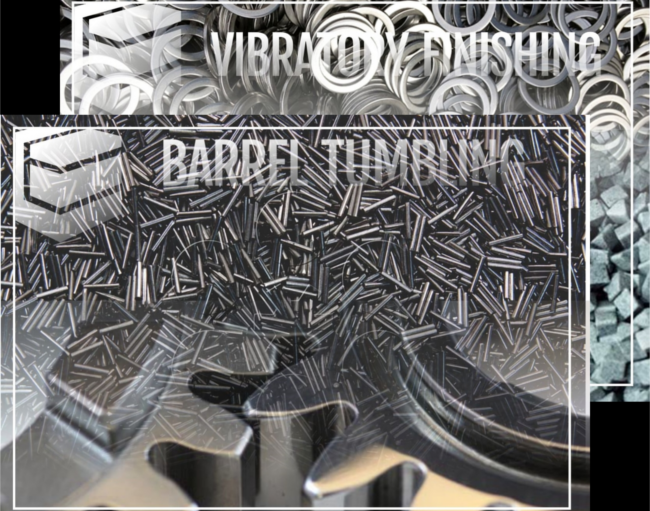Mass finishing technologies like barrel tumblers and vibratory machines enable us to finish massive quantities of parts in a short time.
However, some customers raise concerns about the impact mass metal finishing will have on their products. Will barrel tumbling or vibratory finishing cause damage to metal parts?

An experienced mass metal finisher will understand the measures one must take to avoid damaging the parts during the finishing process. These considerations include:
- Choosing the correct finishing method for the part
- Selecting an appropriate media
- Filling the chamber with a proper media-to-part ratio
- Adjusting machine settings
With proper preparation and media selection, metal parts should survive the barrel tumbling or vibratory finishing process unscathed — save for the imperfections the process is designed to remove.
Mass Metal Finishing: Vibratory Finishing vs Barrel Tumbling
Vibratory finishing and barrel tumbling are methods of preparing metal parts for coating. Both processes are widely used for polishing, burnishing, de-scaling, de-flashing, radiusing, and deburring services.
The difference between barrel tumbling and vibratory finishing is how the machines create the friction required to remove imperfections from the metal parts.
In barrel tumbling, the parts are placed in a tumbling barrel along with finishing media (small pieces of metal, ceramic, or other materials) and compounds (like cleaners and polish). The barrel rotates at a set speed, causing the parts inside to tumble against the media and each other.
With vibratory finishing, the parts, media and compounds are placed into a tub, and instead of spinning like a barrel tumbler, the tub vibrates rapidly. The vibration causes the parts and media to rub together.
For some parts, the force of barrel tumbling is necessary to get a good, clean finish; in other cases, barrel tumbling is too harsh, even with a lighter choice of media. Vibratory finishing is generally easier on parts than barrel tumbling. The correct choice depends both on the part and the desired finish.
Choosing the Correct Finishing Method
The shape and size of the metal parts in question is a significant factor when choosing the correct finishing method that won’t cause damage.
Simple shapes, like spherical and cube-like parts, can often withstand barrel tumbling with no risk of damage. More delicate parts (with thin pieces, small details, protrusions or openings) tend to be better-suited to a vibratory machine.
Selecting an Appropriate Media
To produce a quality finish, the finishing media must be able to reach all surfaces of the part without causing damage or becoming lodged in gaps or crooks. There is a wide variety of finishing media available for all different types of parts and finishes, the most common of which are made of steel, ceramic, or plastic.
Lighter, smaller media are usually more appropriate for delicate parts, while sturdy parts can go into the barrel with larger, heavier materials.
Media-to-Part Ratio
In addition to rubbing against the parts to remove imperfections, media acts as a cushion that prevents parts from hitting each other too forcefully inside the machine. If there is not enough media between them, the parts will collide and potentially take damage during the finishing process. Delicate parts call for a higher media-to-part ratio.
Machine Settings
Barrel tumblers have adjustable rotation speed, and vibratory machines can vibrate faster or slower depending on the machine’s settings. The person operating the machine must choose settings that fit the job.

